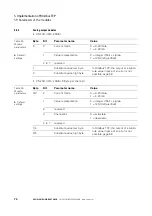
5 Implementation of Modbus TCP
5.4 Structure of the packed in-/ output process data
XI/ON: XNE-GWBR-2ETH-MB
10/2011 MN05002008Z-EN
www.eaton.com
59
5.4
Structure of the packed in-/ output process data
In order to assure a largely efficient access to the process data of a station, the module data
are consistently packed and mapped to a coherent register area.
The I/O-modules are divided into digital and intelligent modules (analog modules, serial inter-
faces, counters…).
Both module types are mapped in separate register ranges.
The data mapping always starts with the mapping of the intelligent modules. Each module
occupies as many Modbus registers as necessary, depending on it’s data width. At least one
register is occupied. A RS232-module, for example, occupies 4 consecutive registers (8 bytes)
in the input and in the output area.
The data byte arrangement is done according to the physical order in the station, from the left
to the right.
The data of the intelligent modules are followed by the data of the digital modules, also struc-
tured according to their physical appearance in the station. The Modbus registers for the digital
data are filled up to 16 bit. This means on the one hand that one Modbus register can contain
data of different digital modules and on the other hand that the data of one digital module can
be distributed over multiple registers. Bit 0 of a digital module is thus not necessarily located
on a word limit.
Note
Relating to the data mapping, the XNE-1SWIRE modules do not belong to the intel-
ligent modules. Theirs process data are mapped in the range of the digital input and
output modules.
Note
An example in Chapter 6.3 Communication examples: Modbus TCP, Page 116. de-
scribes the data mapping. Additionally, the software I/O-ASSISTANT offers the pos-
sibility to create a mapping table for every station.
















































